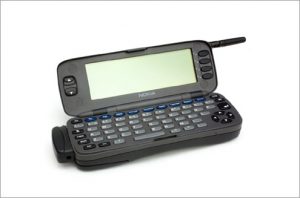Mobile Phones Connect


Date: 01/01/1996
1996 Mobile phones and the Internet
1997 In 1997, PGMedia filed an anti-trust suit against NSI citing the ROOT zone as an essential facility, and the US National ScienceFoundation(NSF) was enjoined to this action. Ultimately, Network Solutions NSI was granted immunity from anti-trust litigation, but the litigation created enough pressure to restructure the domain name market.
1997 May The application that runs almost every DNS server on the Internet is called BIND, for Berkeley Internet Name Domain, first developed as a graduate student project at the University of California at Berkeley, andmaintained through version 4.8.3 by the university’s Computer Systems Research Group (CSRG). The initial BIND development team consisted of Mark Painter, David Riggle, Douglas Terry, and Songnian Zhou. Later work was done by Ralph Campbell and Kevin Dunlap, and others that contributed include Jim Bloom, Smoot Carl-Mitchell, DougKingston, Mike Muuss, Craig Partridge, and Mike Schwartz. Application maintenance was done by Mike Karels and O. Kure.Versions 4.9 and 4.9.1 of BIND were released by then the number two computer company, Digital Equipment Corporation. The lead developer was Paul Vixie, with assistance from Paul Albitz, Phil Almquist, Fuat Baran,Alan Barrett, Bryan Beecher, Andy Cherenson, Robert Elz, Art Harkin, Anant Kumar, Don Lewis, Tom Limoncelli, Berthold Paffrath, Andrew Partan, Win Treese, and Christophe Wolfhugel. After Vixie left to establish Vixie Enterprises, he sponsored the development of BIND Version 4.9.2, and became the application’s principal architect. Versions 4.9.3 on have been developed and maintained by the Internet Systems Consortium. A major architectural update called Version 8 was co-developed by Bob Halley and Paul Vixie and released in May 1997. Another major architectural rewrite called Version 9 with enhanced security support was developed and released in the year 2000.
1997 There are two ccTLDs that have been deleted after the corresponding 2-letter code was withdrawn from ISO 3166-1: cs (forCzechoslovakia) and zr (for Zaire). There may be a significant delay between withdrawal from ISO 3166-1 and deletion from the DNS; for example, ZR ceased to be an ISO 3166-1 code in 1997, but the zr ccTLD was not deleted until 2001.Other ccTLDs corresponding to obsolete ISO 3166-1 have not yet been deleted. In some cases they may never be deleted due to the amount of disruption this would cause for a heavily used ccTLD. In particular, the Soviet Union’s ccTLD su remains in use more than a decade after SU was removed from ISO 3166-1.
1997 By the mid-1990s there was discussion of introduction of more TLDs. Jon Postel, as head of IANA, invited applications from interested parties. In early 1995, Postel created “Draft Postel”, an Internet draft containing the procedures to create new domain name registries and new TLDs. Draft Postel created a number of small committees to approve the newTLDs. Because of the increasing interest, a number of large organizations took overthe process under the Internet Society’s umbrella. This second attempt involved setting up a temporary organization called the International Ad HocCommittee (IAHC). On February 4, 1997, the IAHC issued a report ignoring theDraft Postel recommendations and instead recommended the introduction of seven new TLDs (arts, firm, info, nom,rec, store, and web). However, these proposals were abandoned after the U.S. government intervened.
1998 In addition to his role as the RFC Editor, Jon Postel worked as the manager of IANA until his death in 1998.